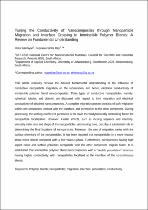 ResearchSpace
ResearchSpace
Tuning the conductivity of nanocomposites through nanoparticle migration and interface crossing in immiscible polymer blends: A review on fundamental understanding
JavaScript is disabled for your browser. Some features of this site may not work without it.
- ResearchSpace
- →
- Research Publications/Outputs
- →
- Journal Articles
- →
- View Item
| dc.contributor.author |
Salehiyan, Reza

|
|
| dc.contributor.author |
Ray, Suprakas S

|
|
| dc.date.accessioned | 2018-11-29T10:50:34Z | |
| dc.date.available | 2018-11-29T10:50:34Z | |
| dc.date.issued | 2018-10 | |
| dc.identifier.citation | Salehiyan, R. and Ray, S.S. 2018. Tuning the conductivity of nanocomposites through nanoparticle migration and interface crossing in immiscible polymer blends: A review on fundamental understanding. Macromolecular Materials and Engineering, vol 0(0), pp 9336- 9347 | en_US |
| dc.identifier.issn | 1438-7492 | |
| dc.identifier.issn | 1439-2054 | |
| dc.identifier.uri | https://onlinelibrary.wiley.com/doi/full/10.1002/mame.201800431 | |
| dc.identifier.uri | http://hdl.handle.net/10204/10559 | |
| dc.description | Copyright: 2018 Wiley Online Library. Due to copyright restrictions, the attached PDF file only contains the preprint version of the published article. For access to the published version, please consult the publisher's website. The definitive version of the work is published in Macromolecular Materials and Engineering, vol 0(0), pp 9336- 9347 | en_US |
| dc.description.abstract | This article critically reviews the detailed fundamental understanding of the influence of conductive nanoparticle migration on the localization, and hence, electrical conductivity of immiscible polymer blend nanocomposites. Three types of conductive nanoparticles, namely, spherical, tubular, and platelet, are discussed with respect to their migration and electrical conductivity of obtained nanocomposites. A complete migration process consists of bulk migration within one component, contact with the interface, and penetration to the other component. During processing, the wetting coefficient parameter is the main thermodynamically controlling factor for nanoparticle localization. However, kinetic effects, such as mixing sequence and intensity, viscosity ratio, size and shape of the nanoparticles, and mixing time, can play a substantial role in determining the final locations of nanoparticles. Moreover, the rate of migration varies with the surface chemistry of the nanoparticles. It has been reported that nanoparticles in a more viscous phase move slower compared with a low viscous phase. Furthermore, nanoparticles having high aspect ratios and surface polarities compatible with the other component migrating faster. It is established that immiscible polymer blend nanocomposites with a “double percolation” structure having higher conductivity with nanoparticles are localized at the interface of the co-continuous blends. | en_US |
| dc.language.iso | en | en_US |
| dc.publisher | Wiley Online Library | en_US |
| dc.relation.ispartofseries | Workflow;21722 | |
| dc.subject | Nanoparticle migration | en_US |
| dc.subject | Polymer blend nanocomposites | en_US |
| dc.title | Tuning the conductivity of nanocomposites through nanoparticle migration and interface crossing in immiscible polymer blends: A review on fundamental understanding | en_US |
| dc.type | Article | en_US |
| dc.identifier.apacitation | Salehiyan, R., & Ray, S. S. (2018). Tuning the conductivity of nanocomposites through nanoparticle migration and interface crossing in immiscible polymer blends: A review on fundamental understanding. http://hdl.handle.net/10204/10559 | en_ZA |
| dc.identifier.chicagocitation | Salehiyan, Reza, and Suprakas S Ray "Tuning the conductivity of nanocomposites through nanoparticle migration and interface crossing in immiscible polymer blends: A review on fundamental understanding." (2018) http://hdl.handle.net/10204/10559 | en_ZA |
| dc.identifier.vancouvercitation | Salehiyan R, Ray SS. Tuning the conductivity of nanocomposites through nanoparticle migration and interface crossing in immiscible polymer blends: A review on fundamental understanding. 2018; http://hdl.handle.net/10204/10559. | en_ZA |
| dc.identifier.ris | TY - Article AU - Salehiyan, Reza AU - Ray, Suprakas S AB - This article critically reviews the detailed fundamental understanding of the influence of conductive nanoparticle migration on the localization, and hence, electrical conductivity of immiscible polymer blend nanocomposites. Three types of conductive nanoparticles, namely, spherical, tubular, and platelet, are discussed with respect to their migration and electrical conductivity of obtained nanocomposites. A complete migration process consists of bulk migration within one component, contact with the interface, and penetration to the other component. During processing, the wetting coefficient parameter is the main thermodynamically controlling factor for nanoparticle localization. However, kinetic effects, such as mixing sequence and intensity, viscosity ratio, size and shape of the nanoparticles, and mixing time, can play a substantial role in determining the final locations of nanoparticles. Moreover, the rate of migration varies with the surface chemistry of the nanoparticles. It has been reported that nanoparticles in a more viscous phase move slower compared with a low viscous phase. Furthermore, nanoparticles having high aspect ratios and surface polarities compatible with the other component migrating faster. It is established that immiscible polymer blend nanocomposites with a “double percolation” structure having higher conductivity with nanoparticles are localized at the interface of the co-continuous blends. DA - 2018-10 DB - ResearchSpace DP - CSIR KW - Nanoparticle migration KW - Polymer blend nanocomposites LK - https://researchspace.csir.co.za PY - 2018 SM - 1438-7492 SM - 1439-2054 T1 - Tuning the conductivity of nanocomposites through nanoparticle migration and interface crossing in immiscible polymer blends: A review on fundamental understanding TI - Tuning the conductivity of nanocomposites through nanoparticle migration and interface crossing in immiscible polymer blends: A review on fundamental understanding UR - http://hdl.handle.net/10204/10559 ER - | en_ZA |





